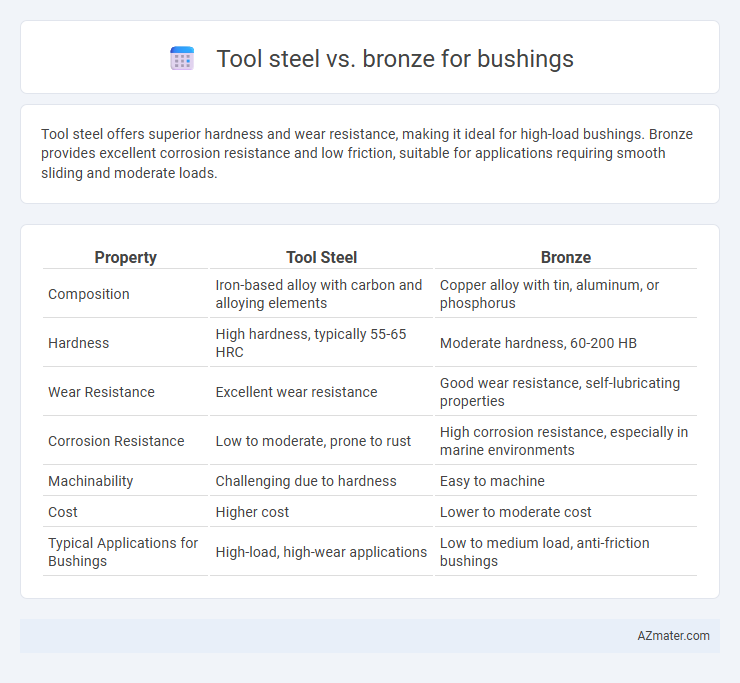Tool steel offers superior hardness and wear resistance, making it ideal for high-load bushings. Bronze provides excellent corrosion resistance and low friction, suitable for applications requiring smooth sliding and moderate loads.
Table of Comparison
| Property | Tool Steel | Bronze |
|---|---|---|
| Composition | Iron-based alloy with carbon and alloying elements | Copper alloy with tin, aluminum, or phosphorus |
| Hardness | High hardness, typically 55-65 HRC | Moderate hardness, 60-200 HB |
| Wear Resistance | Excellent wear resistance | Good wear resistance, self-lubricating properties |
| Corrosion Resistance | Low to moderate, prone to rust | High corrosion resistance, especially in marine environments |
| Machinability | Challenging due to hardness | Easy to machine |
| Cost | Higher cost | Lower to moderate cost |
| Typical Applications for Bushings | High-load, high-wear applications | Low to medium load, anti-friction bushings |
Introduction to Tool Steel and Bronze Bushings
Tool steel bushings offer exceptional hardness, wear resistance, and durability, making them ideal for high-load and high-temperature industrial applications. Bronze bushings provide excellent corrosion resistance, low friction, and good machinability, commonly used in environments requiring smooth rotational movement and reduced maintenance. The choice between tool steel and bronze bushings depends on factors such as load, speed, environmental conditions, and longevity requirements.
Composition and Material Properties
Tool steel bushings exhibit high hardness and wear resistance due to their alloy composition containing carbon, chromium, and vanadium, making them suitable for heavy-duty applications. Bronze bushings are primarily composed of copper with tin and sometimes aluminum or phosphorus, providing excellent corrosion resistance, low friction, and good thermal conductivity. The choice between tool steel and bronze depends on operational demands, with tool steel favored for strength and durability, while bronze offers superior self-lubricating properties and reduced friction in moderate load conditions.
Strength and Durability Comparison
Tool steel bushings exhibit superior strength and wear resistance due to their high carbon and alloy content, making them ideal for heavy-duty applications with high load and impact. Bronze bushings offer excellent corrosion resistance and good durability but generally have lower tensile strength compared to tool steel, making them suitable for moderate load environments with lower friction requirements. The choice between tool steel and bronze for bushings depends on operational demands, with tool steel preferred for maximum strength and longevity under stress, while bronze excels in environments requiring lubrication and corrosion resistance.
Wear Resistance: Tool Steel vs Bronze
Tool steel exhibits superior wear resistance compared to bronze, making it an ideal choice for bushings subjected to high loads and abrasive environments. The hardness and strength of tool steel reduce deformation and surface wear, extending the lifespan of components. Bronze offers good wear resistance but is better suited for applications with lower loads and where self-lubricating properties are advantageous.
Friction Performance and Lubrication Needs
Tool steel bushings exhibit higher wear resistance and lower friction coefficients under dry conditions compared to bronze bushings, making them suitable for heavy-duty applications with minimal lubrication. Bronze bushings offer better self-lubricating properties due to embedded lubricants and softer material composition, reducing maintenance in moderate load environments. Selecting tool steel or bronze bushings depends on operating conditions, balancing friction performance and lubrication requirements for optimal durability and efficiency.
Corrosion Resistance Differences
Tool steel offers higher strength and wear resistance, but is typically more prone to corrosion unless specially treated or alloyed with corrosion-resistant elements like chromium. Bronze bushings naturally exhibit superior corrosion resistance due to their copper content, making them ideal for marine or humid environments. Choosing between tool steel and bronze bushings depends heavily on the specific exposure conditions and maintenance capabilities to prevent corrosion.
Cost and Availability Analysis
Tool steel bushings generally have higher upfront costs compared to bronze due to more intensive manufacturing processes and material expenses. Bronze bushings offer greater availability and cost-effectiveness, benefiting from widespread use in automotive and industrial applications, which drives mass production. Cost analysis favors bronze for budget-sensitive projects, while tool steel is preferred when durability and wear resistance justify the initial investment.
Typical Applications for Each Material
Tool steel bushings are commonly used in high-wear, heavy-load applications such as machinery, automotive components, and metal stamping due to their exceptional hardness and wear resistance. Bronze bushings are preferred in applications requiring excellent corrosion resistance and lubricity, such as marine equipment, electrical motors, and agricultural machinery. Both materials serve critical roles based on operational environment, with tool steel excelling in durability and bronze offering low friction and resistance to galling.
Maintenance and Lifespan Considerations
Tool steel bushings exhibit superior wear resistance and durability, requiring less frequent maintenance and providing a longer lifespan compared to bronze bushings. Bronze bushings demand regular lubrication and maintenance to prevent corrosion and wear, which can significantly reduce their operational life. Selecting tool steel ensures enhanced performance in high-load, high-temperature environments, minimizing downtime and maintenance costs.
Choosing the Right Bushing Material for Your Project
Selecting the right bushing material hinges on application demands, where tool steel offers exceptional hardness and wear resistance suitable for high-load, high-temperature environments, while bronze provides excellent corrosion resistance and good lubrication properties ideal for lower-speed, moderate-load conditions. Tool steel bushings excel in durability and precision but typically require lubrication and maintenance, whereas bronze bushings often function effectively with minimal lubrication due to their self-lubricating qualities. Understanding load capacity, environmental factors, and maintenance expectations ensures optimal bushing performance and longevity in your project.

Infographic: Tool steel vs Bronze for Bushing
 azmater.com
azmater.com